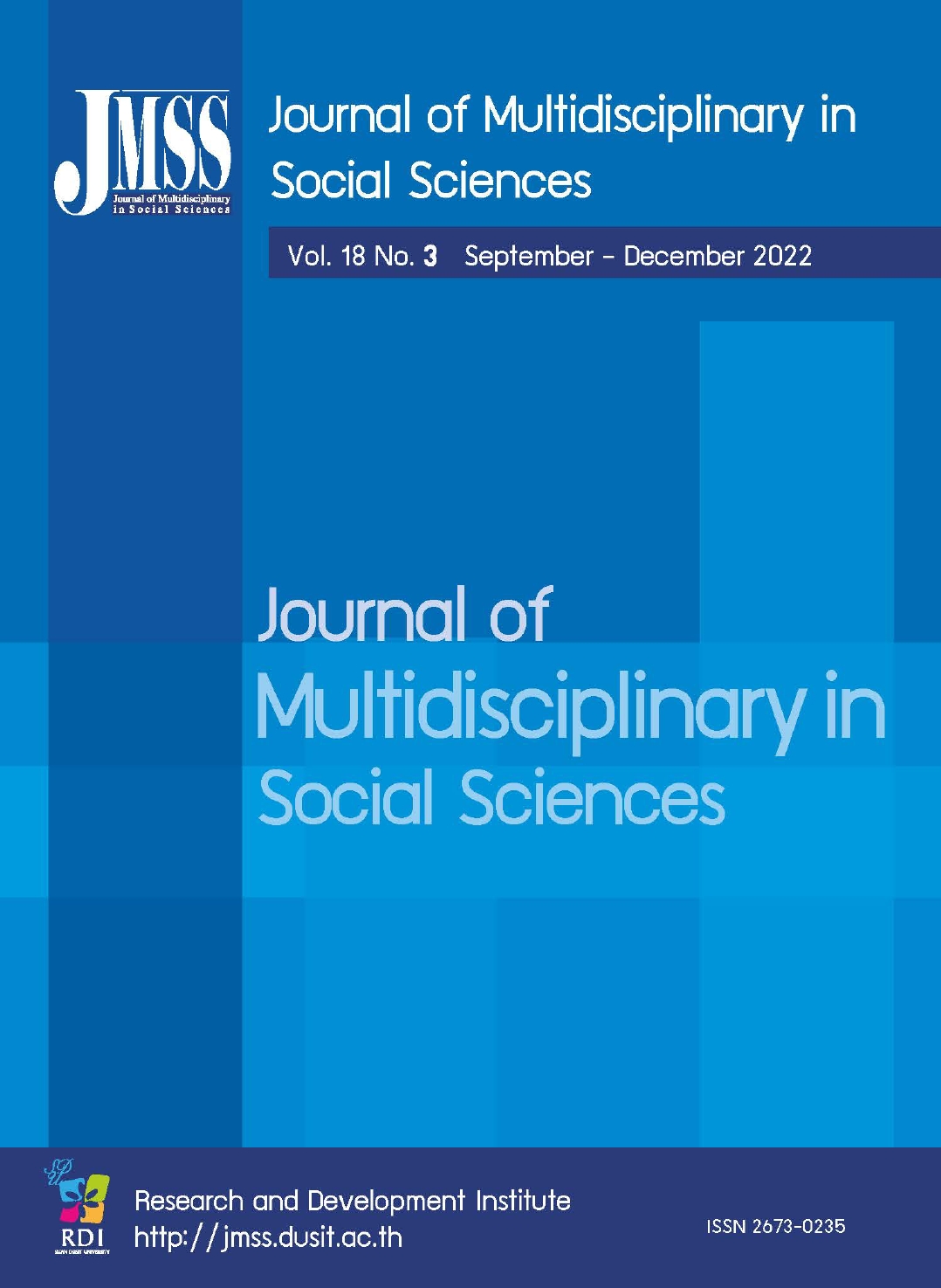Reputation Management of Higher Education Institutions in Thailand
Keywords:
Reputation management, University reputation, Higher education institutionsAbstract
This review article proposes the concept of reputation management of higher education institutions in Thailand. The main purpose is to be a guideline for further development of a tertiary institution with continuous development, flexibility, stability and sustainability, social recognition and ready to face disruptive changes in the future. The detailed content of the article describes abiding by the university reputation management concept including components of university reputation, university reputation management, perspectives on university reputation, university reputation indicators and measurement, factors that impact on university reputation, and ranking of noted higher education institutions.
References
Brown, R. (2010). Reputation management. Business Information Review, 27(1), 56–64 Retrieved 2013, February 23 from http://bir.sagepub.com/content/27/1/56
Chaisamrej, R. (2013). Corporate reputations: Survey of literature review and theoretical concepts for factor driven study on reputation in all business dimensions. Retrieved 2015, March 2 from http://www.ejournal.su.ac.th/upload/662.pdf
Chinavorn, A. (2010). Public relations media. Bangkok: Chulalongkorn University. Chotevithayathanin, N. (2016). Reputation management strategies for Rajabhat University. Doctoral dissertation. Department of Educational Policy Management and Leadership, Faculty of Education, Chulalongkorn University.
Curtin, P. (2009). Managing university reputations. 4th Asia Pacific Conference on Educational Integrity (4APCEI) 28–30 September 2009 University of Wollongong NSW Australia. Retrieved 2014, November 14 from http://ro.uow.edu.au/cgi/viewcontent.cgi?article=1033&context=apcei
Dickinson-Delaporte, S., Beverland, M. & Lindgreen, A. (2010). Building corporate reputation with stakeholders: Exploring the role of message ambiguity for social marketers. European Journal of Marketing, 44(11/12), 1856-1874. Retrieved 2013, March 18 from http://www.emeraldinsight.com/journals.htm?issn=0309-0566&volume=44&issue=11&articleid=1891433&show=pdf
Doorley, J. & Garcia, H. F. (2011) Reputation management: The key to successful public relations and corporate communication. 2nd edition. New York, NY: Routledge.
Dowling, G. R. (2002). Creating corporate reputations: Identity, image, and performance. Oxford: Oxford University Press. Drexel University's LeBow College of Business. Center for Corporate Reputation Management. n.d. The importance of reputation. Retrieved 2014, November 14 from http://www.lebow.drexel.edu/academics/centers/reputation-management/importance-reputation
Environment management system (ISO 14001). (n.d.) Retrieved 2015, May 1 from http://www.anav.co.th/iso14001.html
Gaines-Ross, L. (2008). Corporate reputation: 12 steps to safeguarding and recovering reputation. Hoboken: John Wiley & Sons.
Haywood, R. (c2005). Corporate reputation, the brand & the bottom line: Powerful proven communication strategies for maximizing value. London: Kogan Page.
He, H. (2010). Indicators for reputation measurement of communication universities in China. Communication Arts Thesis, Department of Public Relations, Faculty of Communication Arts, Chulalongkorn University.
He, H. and Pitpreecha R. (2011). Indicators for reputation measurement of communication universities in China. Journal of Public Relations and Advertising, (4),2, 102-123.
Jaicharnsukkit, P. (2009). Corporate image & brand managementWhen reputation is a capital worth greater than the property of the organization. Retrieved 2013, June 2 from http://www.drphot.com/images/journal/2552/brandmarketing52/Article%20Corp%20Image%20Apr%2009.pdf
Kecharananta, N. (2009). Strategic management. Revised. Bangkok: Se-Ed Book. Khlaiophas, N. & Pitpreecha, R. (2009). Corporate reputation indicator for life insurance business in Thailand. Journal of Public Relations and Advertising, 2(2), 127-147.
Kongsompong, K. (2009). Multicultural marketing management. Bangkok: Sasin Graduate Institute of Business Administration, Chulalongkorn University.
Laphirattanakun, W. (2010). Public relations. 12th edition. Bangkok: Chulalongkorn University. Laukaikul, S. (2007). Sufficiency Branding. Bangkok: Manager Weekly.
Manager Weekly 360 Degree. (2005). 10 reasons why employees ‘stay’ or ‘go’ from the organization. Retrieved 2013, June 2 from http://www.manager.co.th/mgrWeekly/ViewNews.aspx?NewsID=9480000159373
Nonthnathorn, P. (2010). Corporate social responsibility management: Creating sustainable competitive advantage. Bangkok: ThinkbeyondBook.
Office for National Education Standards and Quality Assessment (Public Organization). (2012). Manual for higher education institutions the third-round of external quality assessment for higher education 2011- 2015 (Revised November 2011). 2nd edition. Bangkok:
Office for National Education Standards and Quality Assessment (Public Organization). Oxford University Centre for Corporate Reputation. (2008). Research into all aspects of reputation. Retrieved 2016, September 14 from http://www.sbs.ox.ac.uk/facultyresearch/reputation/research-and-publications
Pattanabunboon, P. & Anantachart, S. (2009). Influences of corporate image on service brand extension. Journal of Communication Arts, 27(2), 117-147.
Pitpreecha, R. (2008). The concepts of corporate reputation management for lasting recognition. Journal of Public Relations and Advertising, 1(1), 28-37.
Pitpreecha, R. (2010). Indicators for measuring business reputation in Thailand. Bangkok: Communication Arts, Chulalongkorn University.
Pitpreecha, R. (2011). Indicators for measuring university reputation in Thailand. Bangkok: Communication Arts, Chulalongkorn University.
Rattananakin, S. (2011). Vision and strategies for image building of Thai higher education institutions and higher education personnel. Retrieve 2013, July 23 from http://cuast.net/wp-content/uploads/2011/01/%E0%B8%9A%E0%B8%A3%E0%B8%A3%E0%B8%A2%E0%B8%B2%E0%B8%A2%E0%B8%9C%E0%B8%A8.%E0%B8%AA%E0%B8%B8%E0%B8%98%E0%B8%B5%E0%B8%A3%E0%B9%8C.ppt
Reddiar, C., Kleyn, N. & Abratt, R. (2012). Director’s perspectives on the meaning and dimensions of corporate reputation. South Africa Journal of Business Management, 43(3), 29-39.
Ruenrom, G. (2013). Corporate brand success valuation. Bangkok: CyberPrint. Saengratanadet, P. (2010). How to build corporate brand? Retrieved 2013, September 10 from http://www.brandage.com/Modules/DesktopModules/Article/ArticleDetail.aspx?tabID=7&ArticleID=6518&ModuleID=701&GroupID=1532
Santawee, K. (2012). The factors influencing corporate reputation and corporate reputation management in Thailand. Doctoral dissertation. Faculty of Communication Arts, Chulalongkorn University. Schultz, HB & Werner A. (n.d.). Reputation management. Retrieved 2013, August 9 from http://www.oxford.co.za/download_files/cws/Reputation.pdf
Sherman, M. L. (1999). Making the most of your reputation. In Reputation management: Strategies for protecting companies, their brands and their directors, 9-15. London: Kogan Page.
Sriwiboon, S. (2004). Corporate identity design. 2nd edition. Nonthaburi: Core Function. Techakana. J., 2016, 27 January. Interview. The Times Higher Education World Reputation Rankings. (2013). Retrieved 2013, July 14 from http://www.timeshighereducation.co.uk/world-university-rankings/2013/reputation-ranking
Wongkiatrat, W. & others. (2005). Strategic planning: The art of mapping organization towards excellence. 3rd edition. Bangkok: Innographic.
Wongkiatrat, W. (2011). Principles and practices in strategic planning of government agencies in a performanceoriented budgeting system. 3rd edition. Bangkok: Chulalongkorn University.
Downloads
Published
How to Cite
Issue
Section
License

This work is licensed under a Creative Commons Attribution-NonCommercial-NoDerivatives 4.0 International License.








